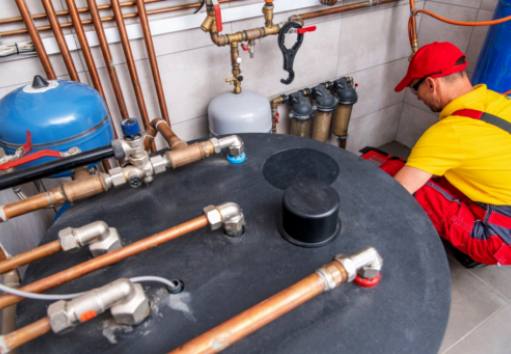Installing a garbage disposal is a practical and valuable addition to any modern home. With the right tools and a little bit of know-how, the installation process can be straightforward and manageable. In this guide, we will provide you with step-by-step instructions for successfully installing a garbage disposal in your home. From selecting the right disposal unit to connecting the drainage assembly, we will cover all the necessary steps to ensure a smooth and efficient installation process. So, roll up your sleeves and get ready to upgrade your kitchen with a new garbage disposal!

Preparation for Installation
This will help to ensure a smooth and efficient installation. It is also essential to take safety precautions, such as turning off the power to the old disposal unit and disconnecting it from the electrical and plumbing systems. Additionally, it is recommended to thoroughly clean the area where the new disposal unit will be installed to provide a clean and safe work environment. By taking the time to properly prepare for the installation, you can help to ensure that the process goes smoothly and that the new disposal unit is installed correctly.
Selecting the Right Garbage Disposal
There are several factors to consider when choosing a disposal unit, including the size and power of the motor, the type of grinding components, and the overall durability and longevity of the unit. It is important to assess your specific needs and the demands of your household in order to make the best choice for your new garbage disposal. With the right selection, you can ensure that your new disposal unit will effectively and efficiently handle the food waste in your home for years to come.
Tools and Materials Needed
When preparing to install a new garbage disposal, it is important to have the necessary tools and materials on hand to ensure a successful and efficient installation process. Some of the key items you will need include a screwdriver, adjustable wrench, plumber's putty, electrical wire connectors, wire nuts, and a hacksaw. Additionally, you will need to have the new garbage disposal unit itself, as well as the necessary mounting hardware, such as brackets and screws. It is also important to have a bucket or container on hand to catch any water or debris that may come out during the removal of the old disposal unit. By gathering all of the necessary tools and materials before beginning the installation process, you can ensure that you are fully prepared to complete the project without any delays.
Removing the Old Disposal Unit
Removing the old disposal unit can seem like a daunting task, but with the right tools and approach, it can be done efficiently and safely. Before starting, be sure to turn off the power to the disposal unit at the main circuit breaker to avoid any risk of electric shock. Next, disconnect the drain and dishwasher hoses from the disposal unit. Use a screwdriver to loosen the hose clamps and carefully remove the hoses from the disposal. Once the hoses are disconnected, use a pipe wrench to loosen the mounting assembly that holds the disposal unit in place. Support the weight of the disposal unit as you loosen the mounting assembly, and carefully lower the unit to the ground once it is free. With the disposal unit removed, you can now focus on preparing the area for the installation of the new unit. This may involve cleaning and inspecting the mounting area and drainage pipes to ensure they are in good condition and free of any buildup or damage.
Mounting and Wiring the New Disposal
Start by attaching the mounting assembly to the bottom of the sink and securing it in place. Then, carefully connect the electrical wires from the disposal unit to the electrical supply, ensuring that the connections are tight and secure. It is important to follow the manufacturer's instructions for wiring to ensure safety and proper functioning of the disposal unit. Once the disposal is securely mounted and wired, you can proceed to the next step in the installation process.
Connecting the Drainage Assembly
Begin by inserting the rubber gasket into the discharge opening of the disposal unit. Then, place the backup flange on top of the rubber gasket and secure it in place with the mounting ring. Use a screwdriver to tighten the mounting ring and ensure that it is snug and secure.
Next, connect the drainage pipe to the backup flange. Apply plumber's putty around the opening of the drainage pipe and then insert it into the backup flange. Use a wrench to tighten the connection and ensure that there are no leaks. Once the drainage pipe is securely connected, reattach the P-trap and the other components of the drainage assembly. Make sure that all connections are tightened and secure.
Finally, turn on the water and test the disposal unit to check for any leaks or issues with the drainage assembly. Run water through the disposal unit and listen for any unusual sounds or vibrations. If everything appears to be working properly, the installation of the garbage disposal unit is complete.
Final Steps and Testing
First, double-check all the connections to ensure everything is tight and secure. Make sure the disposal unit is properly aligned with the drain pipes and there are no leaks.
Next, turn on the power to the disposal unit and test it by running water and food scraps through it. Listen for any unusual noises or vibrations, as this could indicate an installation issue.
If everything is running smoothly, you can now seal up any remaining connections with plumber's putty or sealing tape to prevent any potential leaks.
Finally, take a moment to review the manufacturer's instructions for any specific recommendations or additional steps for your particular disposal unit. This can include information on maintenance and troubleshooting tips to keep your new garbage disposal running efficiently for years to come.
